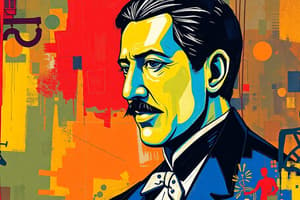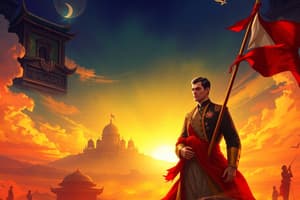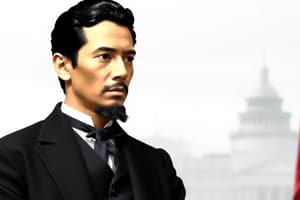Podcast
Questions and Answers
How did the Catholic Church react to the enactment of Republic Act 1425, also known as the Rizal Law?
How did the Catholic Church react to the enactment of Republic Act 1425, also known as the Rizal Law?
- The Catholic Church opposed the law due to Rizal's criticisms of the Church in his novels. (correct)
- The Catholic Church remained neutral, not expressing any opinions on the law.
- The Catholic Church proposed amendments to ensure a more favorable portrayal of religious figures.
- The Catholic Church fully supported the law because it promoted moral values.
Which of the following best describes the main goal of Rizal's founding of the Liga Filipina?
Which of the following best describes the main goal of Rizal's founding of the Liga Filipina?
- To establish a Filipino colony in Borneo as an alternative to Spanish rule.
- To directly overthrow the frailocracy through subversive actions.
- To promote peaceful reforms through legal and non-violent means. (correct)
- To instigate an armed revolution against the Spanish colonial government.
What was the primary reason for Rizal's initial return to the Philippines in 1887 after his time in Europe?
What was the primary reason for Rizal's initial return to the Philippines in 1887 after his time in Europe?
- To spread his reformist ideas and assess the impact of *Noli Me Tangere*. (correct)
- To escape political persecution in Spain due to his reformist writings.
- To permanently settle in his hometown and practice ophthalmology.
- To lead a revolutionary movement against the Spanish colonial government.
In what way did Rizal's El Filibusterismo differ in its political perspective from his previous novel, Noli Me Tangere?
In what way did Rizal's El Filibusterismo differ in its political perspective from his previous novel, Noli Me Tangere?
What was Rizal's main argument in advocating for education for Filipinos?
What was Rizal's main argument in advocating for education for Filipinos?
Why was Rizal exiled to Dapitan?
Why was Rizal exiled to Dapitan?
What role did La Solidaridad play in the Propaganda Movement?
What role did La Solidaridad play in the Propaganda Movement?
The rivalry between Rizal and Marcelo H. del Pilar primarily concerned what aspect of the Propaganda Movement?
The rivalry between Rizal and Marcelo H. del Pilar primarily concerned what aspect of the Propaganda Movement?
What was the significance of the intended Sabah Project for Rizal?
What was the significance of the intended Sabah Project for Rizal?
What was the primary accusation against Rizal during his trial that led to his execution?
What was the primary accusation against Rizal during his trial that led to his execution?
Flashcards
What is RA 1425 (Rizal Law)?
What is RA 1425 (Rizal Law)?
Republic Act mandating the study of Rizal's life and works in all Philippine schools to instill nationalism.
Who was José Rizal?
Who was José Rizal?
José Protacio Rizal Mercado y Alonzo Realonda, born on June 19, 1861, in Calamba, Laguna.
What was the impact of Rizal's novels?
What was the impact of Rizal's novels?
Rizal's novels, particularly Noli Me Tangere and El Filibusterismo, exposed the abuses of the Spanish friars and colonial government, advocating for reforms.
What was La Liga Filipina?
What was La Liga Filipina?
Signup and view all the flashcards
What were Rizal's main political views?
What were Rizal's main political views?
Signup and view all the flashcards
Why was Rizal executed?
Why was Rizal executed?
Signup and view all the flashcards
Who is Laong Laan?
Who is Laong Laan?
Signup and view all the flashcards
Who is Pablo Sanchez?
Who is Pablo Sanchez?
Signup and view all the flashcards
Study Notes
- Republic Act 1425, also known as Rizal Law, was enacted on June 12, 1956.
- President Ramon Magsaysay signed the Rizal Law.
- The Rizal Law aims to instill nationalism through studying Rizal's life and works.
- The Catholic Church opposed the Rizal Law because of Rizal's criticisms in his novels.
Early Life and Education
- Rizal's full name is José Protacio Rizal Mercado y Alonzo Realonda.
- He was born on June 19, 1861, in Calamba, Laguna.
- His parents were Francisco Mercado and Teodora Alonzo.
- Rizal had 10 siblings, including sisters Saturnina and Soledad.
- Rizal's first school was in Biñan, Laguna, under teacher Justiniano Aquino Cruz.
- He attended Ateneo Municipal de Manila, earning a Bachelor of Arts degree.
- Rizal studied Philosophy and Medicine at the University of Santo Tomas (UST).
- He later studied Ophthalmology in UST and continued in Madrid, Spain.
- Rizal specialized in eye surgery under Dr. Otto Becker in Germany.
Rizal’s Life Abroad
- Rizal left Spain in June 1887 via steamer.
- He returned to the Philippines in August 1887.
- The purpose of his return was to spread reformist ideas and test the impact of Noli Me Tangere.
- Leading figures: Rizal, Marcelo H. del Pilar, Graciano López Jaena
- La Solidaridad was a newspaper used to promote reforms.
- Rizal and Marcelo H. del Pilar had a leadership rivalry within the movement.
- Rizal was arrested on July 6, 1892.
- He was deported to Dapitan on July 17, 1892.
- In Dapitan, he practiced medicine, established a school, and developed a water system.
- He also promoted agriculture during his exile.
- Pablo Sanchez was his favorite steamer.
Novels and Political Views
- Noli Me Tangere was published in 1887
- El Filibusterismo was published in 1891.
- Noli Me Tangere calls for reforms and depicts abuses of friars.
- El Filibusterismo advocates revolution.
- Rizal supported education for Filipinos (Por la Educación).
- He criticized the power of the friars (frailocracy).
Rizal’s Final Days
- Rizal was accused of rebellion, sedition, and forming illegal societies.
- He denied involvement in the revolution.
- He was sentenced to death by firing squad.
- Rizal was 35 years old at the time of his execution.
- He was executed on December 30, 1896.
- The execution occurred in Bagumbayan (Luneta).
- Rizal's last words were "Consummatum est" (It is finished).
- He was secretly buried in Paco Cemetery.
Other Key Terms & Concepts
- Rizal founded the Liga Filipina, which aimed for peaceful reforms.
- The Sabah Project was a proposed Filipino colony in Borneo.
- Theodicy refers to Rizal’s reflections on God and suffering.
- Peninsulares were Spanish-born Spaniards.
- Insulares were Philippine-born Spaniards.
- The Galleon Trade and Suez Canal brought economic changes in the 19th century.
- "The youth is the hope of our future."
- “No slave deserves to be free unless he knows how to be free.”
RA 1425 & Nationalism
- RA 1425 promotes Rizal’s philosophy of education & nationalism.
- It encourages studying Rizal's works to inspire patriotism.
- Key objectives include developing moral character, upholding civic conscience, and fostering national identity.
Studying That Suits You
Use AI to generate personalized quizzes and flashcards to suit your learning preferences.




